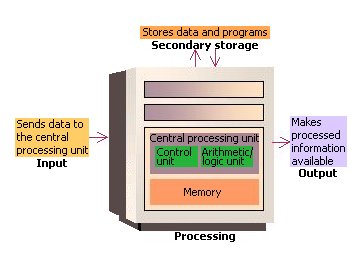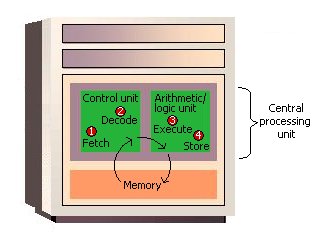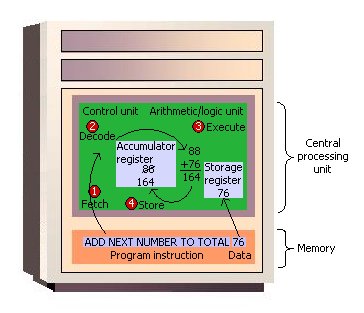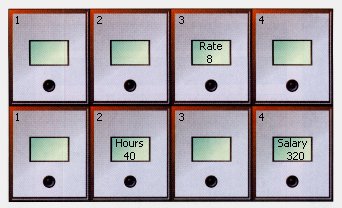Saturday, October 19, 2019
11.Explain how a plane mirror can form a real image.
The image formed by a plane mirror is always virtual (meaning that the light rays do not actually come from the image), upright, and of the same shape and size as the object it is reflecting. A virtual image is a copy of an object formed at the location from which the light rays appear to come.
10.How does computer work.
How Computers Work: The CPU and Memory
Figure 0 shows the parts of a computer:
|
|
This part of the reading will examine the CPU, Buses, Controllers, and Main Memory. Other sections will examine input devices, output devices, and secondary memory.
The Central Processing Unit (CPU)
 |
| Figure 1: The Central Processing Unit |
Before we discuss the control unit and the arithmetic/logic unit in detail, we need to consider data storage and its relationship to the central processing unit. Computers use two types of storage: Primary storage and secondary storage. The CPU interacts closely with primary storage, or main memory, referring to it for both instructions and data. For this reason this part of the reading will discuss memory in the context of the central processing unit. Technically, however, memory is not part of the CPU.
Recall that a computer's memory holds data only temporarily, at the time the computer is executing a program. Secondary storage holds permanent or semi-permanent data on some external magnetic or optical medium. The diskettes and CD-ROM disks that you have seen with personal computers are secondary storage devices, as are hard disks. Since the physical attributes of secondary storage devices determine the way data is organized on them, we will discuss secondary storage and data organization together in another part of our on-line readings.
Now let us consider the components of the central processing unit.
The control unit of the CPU contains circuitry that uses electrical signals to direct the entire computer system to carry out, or execute, stored program instructions. Like an orchestra leader, the control unit does not execute program instructions; rather, it directs other parts of the system to do so. The control unit must communicate with both the arithmetic/logic unit and memory.
The arithmetic/logic unit (ALU) contains the electronic circuitry that executes all arithmetic and logical operations.
The arithmetic/logic unit can perform four kinds of arithmetic operations, or mathematical calculations: addition, subtraction, multiplication, and division. As its name implies, the arithmetic/logic unit also performs logical operations. A logical operation is usually a comparison. The unit can compare numbers, letters, or special characters. The computer can then take action based on the result of the comparison. This is a very important capability. It is by comparing that a computer is able to tell, for instance, whether there are unfilled seats on airplanes, whether charge- card customers have exceeded their credit limits, and whether one candidate for Congress has more votes than another.
Logical operations can test for three conditions:
- Equal-to condition. In a test for this condition, the arithmetic/logic unit compares two values to determine if they are equal. For example: If the number of tickets sold equals the number of seats in the auditorium, then the concert is declared sold out.
- Less-than condition. To test for this condition, the computer compares values to determine if one is less than another. For example: If the number of speeding tickets on a driver's record is less than three, then insurance rates are $425; otherwise, the rates are $500.
- Greater-than condition. In this type of comparison, the computer determines if one value is greater than another. For example: If the hours a person worked this week are greater than 40, then multiply every extra hour by 1.5 times the usual hourly wage to compute overtime pay.
A computer can simultaneously test for more than one condition. In fact, a logic unit can usually discern six logical relationships: equal to, less than, greater than, less than or equal to, greater than or equal to, and not equal.
The symbols that let you define the type of comparison you want the computer to perform are called relational operators. The most common relational operators are the equal sign(=), the less-than symbol(<), and the greater-than symbol(>).
- Registers: Temporary Storage Areas
Registers are temporary storage areas for instructions or data. They are not a part of memory; rather they are special additional storage locations that offer the advantage of speed. Registers work under the direction of the control unit to accept, hold, and transfer instructions or data and perform arithmetic or logical comparisons at high speed. The control unit uses a data storage register the way a store owner uses a cash register-as a temporary, convenient place to store what is used in transactions.
Computers usually assign special roles to certain registers, including these registers:- An accumulator, which collects the result of computations.
- An address register, which keeps track of where a given instruction or piece of data is stored in memory. Each storage location in memory is identified by an address, just as each house on a street has an address.
- A storage register, which temporarily holds data taken from or about to be sent to memory.
- A general-purpose register, which is used for several functions.
- Memory and Storage
Memory is also known as primary storage, primary memory, main storage, internal storage, main memory, and RAM (Random Access Memory); all these terms are used interchangeably by people in computer circles. Memory is the part of the computer that holds data and instructions for processing. Although closely associated with the central processing unit, memory is separate from it. Memory stores program instructions or data for only as long as the program they pertain to is in operation. Keeping these items in memory when the program is not running is not feasible for three reasons:- Most types of memory only store items while the computer is turned on; data is destroyed when the machine is turned off.
- If more than one program is running at once (often the case on large computers and sometimes on small computers), a single program can not lay exclusive claim to memory.
- There may not be room in memory to hold the processed data.
How do data and instructions get from an input device into memory? The control unit sends them. Likewise, when the time is right, the control unit sends these items from memory to the arithmetic/logic unit, where an arithmetic operation or logical operation is performed. After being processed, the information is sent to memory, where it is hold until it is ready to he released to an output unit.
The chief characteristic of memory is that it allows very fast access to instructions and data, no matter where the items are within it. We will discuss the physical components of memory-memory chips-later in this chapter.
To see how registers, memory, and second storage all work together, let us use the analogy of making a salad. In our kitchen we have:
- a refrigerator where we store our vegetables for the salad;
- a counter where we place all of our veggies before putting them on the cutting board for chopping;
- a cutting board on the counter where we chop the vegetables;
- a recipe that details what veggies to chop;
- the corners of the cutting board are kept free for partially chopped piles of veggies that we intend to chop more or to mix with other partially chopped veggies.
- a bowl on the counter where we mix and store the salad;
- space in the refrigerator to put the mixed salad after it is made.
Now for a more technical example. let us look at how a payroll program uses all three types of storage. Suppose the program calculates the salary of an employee. The data representing the hours worked and the data for the rate of pay are ready in their respective registers. Other data related to the salary calculation-overtime hours, bonuses, deductions, and so forth-is waiting nearby in memory. The data for other employees is available in secondary storage. As the CPU finishes calculations about one employee, the data about the next employee is brought from secondary storage into memory and eventually into the registers.
The following table summarizes the characteristics of the various kinds of data storage in the storage hierarchy.
Storage Speed Capacity Relative Cost ($) Permanent? Registers Fastest Lowest Highest No RAM Very Fast Low/Moderate High No Floppy Disk Very Slow Low Low Yes Hard Disk Moderate Very High Very Low Yes - How the CPU Executes Program Instructions
Let us examine the way the central processing unit, in association with memory, executes a computer program. We will be looking at how just one instruction in the program is executed. In fact, most computers today can execute only one instruction at a time, though they execute it very quickly. Many personal computers can execute instructions in less than one-millionth of a second, whereas those speed demons known as supercomputers can execute instructions in less than one-billionth of a second.
Before an instruction can be executed, program instructions and data must be placed into memory from an input device or a secondary storage device (the process is further complicated by the fact that, as we noted earlier, the data will probably make a temporary stop in a register). As Figure 2 shows, once the necessary data and instruction are in memory, the central processing unit performs the following four steps for each instruction:
Figure 2: The Machine Cycle - The control unit fetches (gets) the instruction from memory.
- The control unit decodes the instruction (decides what it means) and directs that the necessary data be moved from memory to the arithmetic/logic unit. These first two steps together are called instruction time, or I-time.
- The arithmetic/logic unit executes the arithmetic or logical instruction. That is, the ALU is given control and performs the actual operation on the data.
- Thc arithmetic/logic unit stores the result of this operation in memory or in a register. Steps 3 and 4 together are called execution time, or E-time.
The control unit eventually directs memory to release the result to an output device or a secondary storage device. The combination of I-time and E-time is called the machine cycle. Figure 3 shows an instruction going through the machine cycle.
Each central processing unit has an internal clock that produces pulses at a fixed rate to synchronize all computer operations. A single machine-cycle instruction may be made up of a substantial number of sub-instructions, each of which must take at least one clock cycle. Each type of central processing unit is designed to understand a specific group of instructions called the instruction set. Just as there are many different languages that people understand, so each different type of CPU has an instruction set it understands. Therefore, one CPU-such as the one for a Compaq personal computer-cannot understand the instruction set from another CPU-say, for a Macintosh.
It is one thing to have instructions and data somewhere in memory and quite another for the control unit to be able to find them. How does it do this?
Figure 3: The Machine Cycle in Action
The location in memory for each instruction and each piece of data is identified by an address. That is, each location has an address number, like the mailboxes in front of an apartment house. And, like the mailboxes, the address numbers of the locations remain the same, but the contents (instructions and data) of the locations may change. That is, new instructions or new data may be placed in the locations when the old contents no longer need to be stored in memory. Unlike a mailbox, however, a memory location can hold only a fixed amount of data; an address can hold only a fixed number of bytes - often two bytes in a modern computer.
Figure 4: Memory Addresses Like Mailboxes
Figure 4 shows how a program manipulates data in memory. A payroll program, for example, may give instructions to put the rate of pay in location 3 and the number of hours worked in location 6. To compute the employee's salary, then, instructions tell the computer to multiply the data in location 3 by the data in location 6 and move the result to location 8. The choice of locations is arbitrary - any locations that are not already spoken for can be used. Programmers using programming languages, however, do not have to worry about the actual address numbers, because each data address is referred to by a name. The name is called a symbolic address. In this example, the symbolic address names are Rate, Hours, and Salary.
- Now that we see conceptually how a computer works, we will look at the hardware components that make up the internals or a modern computer.
Friday, October 18, 2019
9.Why do in summer, roads often appears to be covered with water when seen from a distance?Explain.
This is due to total internal reflection.In summer during the day time the layers of the air in contact with road becomes very hot while upper layers of the air comparatively cool.The light travels from upper cold layers(denser medium)to lower hot layers(rarer medium)So,it is refracted away from the the normal when the angle of incidence is greater than the critical angle,total internal reflection takes place and the light is reflected .when the refracted rays enter in our eyes roads appears as a pool of water.This pool of water is the image of sky.So, in summer, roads often appears to be covered with water when seen from a distance.
8.Why does the sun look slightly oval when it is near the horizon
The is due to atmospheric refraction when sun is at horizontal(during sunrise and sunset)light from the sun reaches the earth obliquely through the atmosphere. Rays from different parts of sun travels through different parts of the earth's atmosphere.Due to the unequal refraction ,the horizontal diameter appears bigger while the vertical diameter appears shorter .Consequently the sun appears slightly oval at horizon.
7.A ray of light incident normally on a plane mirror.What are the values of glancing angle and angle of deviation?
When a ray of light incident normally on a plane mirror it is reflected normally back in the original path. As we know that glancing angle is the angle between incident ray and plane mirror which is 90o in the given case. ... Since the angle of deviation for a plane mirror is twice the glancing angle, So the angle of deviation is 1800
6.What is mainframe computer?
A data processing system employed mainly in large organizations for various applications, including bulk data processing, process control, industry and consumer statistics, enterprise resource planning, and financial transaction processing.
Mainframes use proprietary operating systems, most of which are based on Unix, and a growing number on Linux. Over the years they have evolved from being room-sized to networked configurations of workstations and servers that are an extremely competitive and cost effective platforms for e-commerce development and hosting. Mainframes are so called because the earliest ones were housed in large metal frames.
Mainframes use proprietary operating systems, most of which are based on Unix, and a growing number on Linux. Over the years they have evolved from being room-sized to networked configurations of workstations and servers that are an extremely competitive and cost effective platforms for e-commerce development and hosting. Mainframes are so called because the earliest ones were housed in large metal frames.
5.Computer virus
Small but insidious piece of programming-code that attacks computer and network systems through 'contaminated' (infected) data files, introduced into a system via disks or internet. As a digital equivalent of biological microorganisms, it attaches itself to the target computer's operating system or other programs, and automatically replicates itself to spread to other computers or networks. Invented in 1960s as a prank, viruses come in thousands of types and versions with new ones being invented every day, each requiring a different cure (see antivirus and vaccine). While a few viruses are harmless diversions, most are malicious and cause widespread and severe damage and may bring down entire communication-networks or websites.
Some are immediately active, others remain latent for weeks or months, or work slowly to avoid detection and cause destruction over long periods. Propagation of computer viruses is a serious crime in many countries. See also Trojan horse, and worm.
Some are immediately active, others remain latent for weeks or months, or work slowly to avoid detection and cause destruction over long periods. Propagation of computer viruses is a serious crime in many countries. See also Trojan horse, and worm.
Thursday, October 17, 2019
4.How does the lateral shift change with the increase in the angle of incidence?
The lateral shift is the perpendicular distance between the path of the ray of light when it emerges from the refracting medium and the path that the ray would have taken had it not been refracted.
The angle of incidence is i and the angle of refraction is r.
Let the thickness of the glass slab, BG be t.
Subscribe to:
Comments (Atom)
